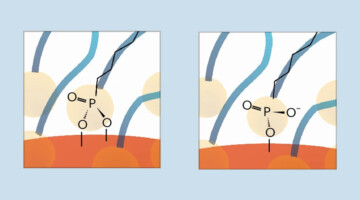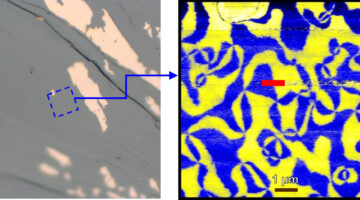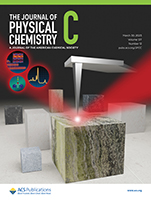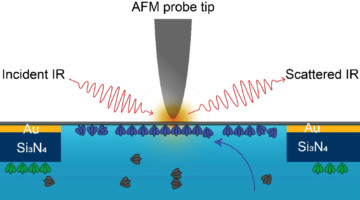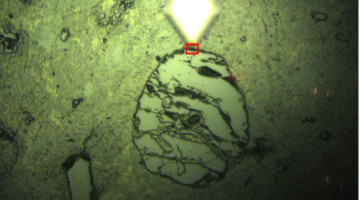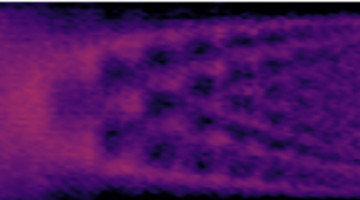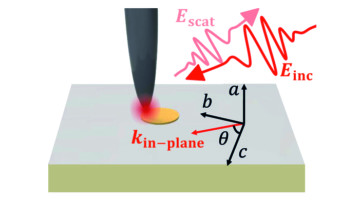Researchers studied samples from corals, mollusks, and sea urchins, at edges where mineral precursors start to form the new shell or skeleton. There, they found a surprise: corals and mollusks produced a mineral precursor that had never been observed before in living organisms or rocks, and had only recently been created synthetically. Read more »
ALS Work Using Infrared Nanospectroscopy
Broadband infrared (IR) light is focused onto the metal tip of an atomic force microscope (AFM). As it scans over the sample, the tip acts as an antenna, directing the light onto a tiny region of the sample. With a spatial resolution up to a thousand times better than conventional Fourier-transform infrared (FTIR) spectroscopy (i.e., below the diffraction limit for IR light), synchrotron infrared nanospectroscopy (also known as SINS) enables the investigation of nanoscale phenomena, even under ambient and environmental conditions that are essentially inaccessible by other techniques. Read more…
Mechanics of a Floating Molecular Layer for CO2 Reduction
Researchers discovered how a layer of organic molecules on a nanoparticle surface detaches to create a highly catalytic pocket for reducing CO2 to CO. The ability to probe molecular-scale events under realistic conditions with nanometer resolution will help guide the design of responsive systems for a wide range of applications, from medicine to optoelectronics. Read more »![]()
![]()
Shedding Light on Sea Creatures’ Secrets
Exactly how does coral make its skeleton, a sea urchin grow a spine, or an abalone form the mother-of-pearl in its shell? A new study at the ALS revealed that this process of biomineralization, which sea creatures use to lock carbon away in their bodies, is more complex and diverse than previously thought. Read more »
Probing Walls between Electrically Polarized Domains
Researchers used infrared light to investigate the properties of the domain walls that separate electrically polarized (ferroelectric) regions in a rare-earth ferrite material. An understanding of domain-wall behavior is relevant to the development of advanced logic and memory applications for ultralow-power digital devices. Read more »![]()
![]()
Raman and Far-Infrared Synchrotron Nanospectroscopy of Layered Crystalline Talc: Vibrational Properties, Interlayer Coupling, and Symmetry Crossover
Talc is an electrical insulator and an excellent target for low-cost, heterostructure-based optoelectronic applications. Here, light-matter interactions and their consequences at the nanoscale-thickness limit are probed using Raman spectroscopy, near-field synchrotron infrared nanospectroscopy, and first-principles calculations. Read more »
A Nano-IR Probe for Proteins in Liquid Environments
A new technique using infrared (IR) light revealed how the self-assembly of proteins is affected by environmental conditions in a surrounding liquid. This nanoscale probe of soft matter in a liquid matrix will facilitate advances in biology, plastics processing, and energy-relevant applications such as electrocatalysts and batteries. Read more »![]()
![]()
Nanoscale Infrared Study of Meteorite Mineralogy
Using a nanoscale infrared probe, researchers found that the minerals in a meteorite—an artifact representing the solar system’s past—were altered by water on very fine spatial scales. The work sheds light on conditions in the early solar system and lays groundwork for analyzing asteroid samples to be returned to Earth by NASA in 2023. Read more »![]()
![]()
Looking Inside a Battery with Infrared Light
Researchers have developed a new infrared methodology with unparalleled spatial and chemical imaging capabilities that helps to characterize processes at the interfaces between electrodes and electrolytes, with an eye toward bringing increased safety, lifetime, and energy density to the next-generation solid-state battery market. Read more »
Infrared Probe of Ultrahigh-Quality Nanoribbon Resonators
Researchers found that ribbon-like thin films, grown through a bottom-up, self-assembly approach, can act as ultrahigh-quality nanoscale resonators of lattice vibrations at infrared frequencies. These ultrathin nanostructures are ideal platforms for applications that harness infrared light, such as thermal emission and molecular sensing. Read more »![]()
![]()
A Powerful Infrared Technique Broadens Its Horizons
Scattering-type scanning near-field optical microscopy (s-SNOM) focuses infrared light to dimensions below the diffraction limit, measuring properties with components perpendicular to the sample surface. Researchers have now devised a way to probe components parallel to the sample, where the technique has been less sensitive. Read more »

